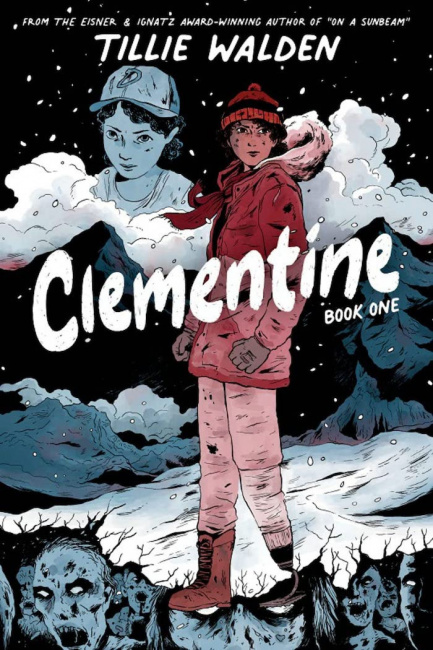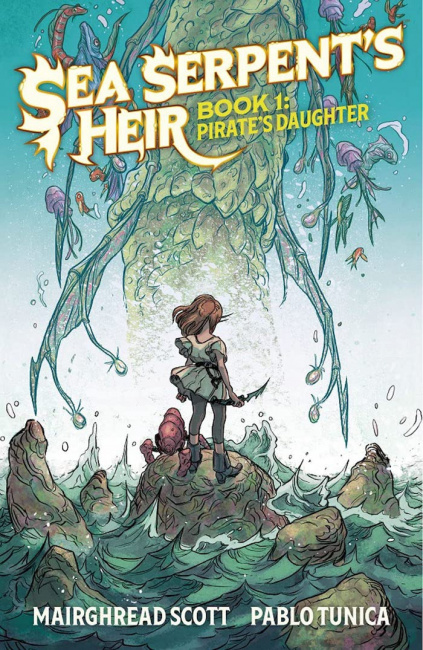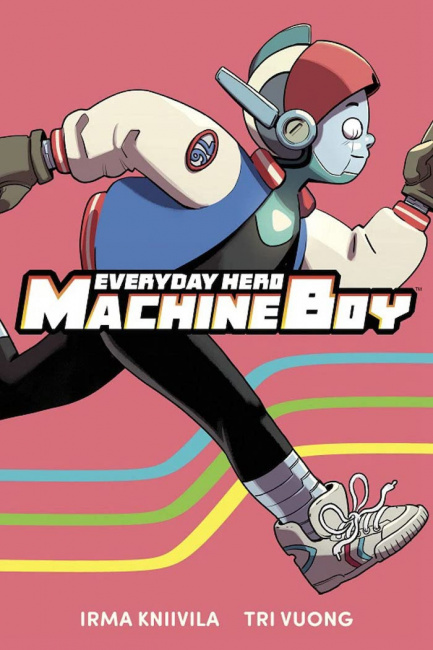It’s been less than a year since the Image studio Skybound announced Comet, a new line of comics for young readers (see “Three Comic Companies Join Rush to Add Young Reader Lines”). The first book in the imprint, Tillie Walden’s Clementine, will debut in June, followed in the fall by Everyday Hero Machine Boy, by Tri Vuong and Irma Kniivila, and The Sea Serpent’s Heir, by Mairghread Scott and Pablo Tunica. We talked to Senior Editor Alex Antone to get a sense of what the thinking is behind this new imprint and what they might be doing in the future.
Skybound already has a lot of successful adult properties, including The Walking Dead. Why did it make sense to add comics for younger readers to the line?
Alex Antone: Starting a Young Readers imprint is something that our entire staff has been passionate about for some time, and that’s always where things start at Skybound – passion for the kind of books we want to create and the creators we want to work with – and I think that shows in the material that we’ve produced in the last 10 years. Beyond that, the Middle Grade and YA graphic novel space is a thriving section of the book market, and we’re eager to bring Skybound’s brand of storytelling to new readers who maybe just started reading comics. It’s very exciting!
How will Comet properties be different from the other middle-grade and YA graphic novels on the market – what will be your niche? And what do you think is their strongest selling point?
We’re bringing Skybound’s specific elevated genre storytelling to the YA and Middle Grade market, where it feels like there is currently a Comet-sized hole. Skybound Comet books will always include elements of fantasy, sci-fi, horror, mystery, romance – or maybe all of the above – from a diverse mix of creators and perspectives. Our goal is to produce both tentpole books like Tillie Walden’s Clementine (our new Walking Dead YA Trilogy) as well as debut original creations like Everyday Hero Machine Boy and Sea Serpent’s Heir, which we believe could become the tentpoles of tomorrow.
Do you expect that adults will pick up your YA comics as well?
Absolutely. I read a ton of YA, and to me, the best Middle Grade comics could also be classified as all-ages comics anyway. Everyday Hero Machine Boy is a great example of that. Or Jeff Smith’s Bone.
In terms of format, will Comet be exclusively graphic novels? Why or why not?
For now! Our goal with these first 3 books is to push firmly into the book market with original graphic novels, but don’t be surprised if you see some future Skybound Comet books pop up as a webcomics or periodical comics first – it’s all about building an audience for the eventual book market release, and we’re taking this on a case-by-case basis – we want to do what’s best for the book and the creator, and that’s a competitive advantage that Skybound has – we can really do it all.
Which channels are you aiming for – the direct market, retail bookstores, mass market, libraries and schools? What about digital – do you think there will be a significant audience there?
Skybound has always been very direct market focused and that’s definitely not changing, but with Skybound Comet specifically, we’re also making a push into the school and library community. For this reason, we’ve made teaching guides available for all Skybound Comet titles because we want to support educators, librarians and parents as much as possible.
There’s also huge, huge opportunity in the broader retail and mass market, so of course, we’ll be focused on those as well, and you can expect more exciting news on the digital comics front very soon…
Are your comics creator-owned? How do you develop them – do you take pitches from creators, or do you develop the concept and then find the creative team?
It really depends on the project, but we definitely accept pitches from creators and sometimes, as in the case of Clementine, we also approach creators for specific projects.
I was really intrigued by Clementine, as it’s a spinoff of The Walking Dead and Tillie Walden is well known as a more literary creator, although once I saw the comic it made perfect sense. How did you come up with this particular concept and what made you think of Tillie Walden?
Who says zombies can’t be literary??
In all seriousness, we just loved her work and thought she’d draw a killer Clementine, but we had no idea if she’d be into it since she’d never worked on something she didn’t create from scratch. After we approached her, we found out she was already a Walking Dead fan (actually her dad was, which made Robert Kirkman feel very old), she pitched a series, we loved it, and things could not have come together any better – Clementine: Book One is Tillie Walden turned up to 11, simultaneously heart-warming, heart-breaking, and heart-pounding.
I did want to call out the important contributions of Cliff Rathburn as well, our beloved colorist who did all the lovely greytones over Tillie’s art that made the final book feel distinctly Tillie Walden but also distinctly Walking Dead. It’s very cool!
Will there be more Walking Dead spin-offs? What about your other properties?
There are no plans to do any other Walking Dead spin-off comics currently, which makes Clementine the only place to find new Walking Dead comics for the foreseeable future! As for other properties…I guess you’ll just have to wait and see!
The Sea Serpent’s Heir is a fantasy adventure comic, which seems to be a really popular genre right now. Why do you think that is, and how will it fit into the current market? What is it comparable to that our readers would already be familiar with?
Teen Titans: Raven is probably the closest comparison, because Raven and Aella (the protagonist in Sea Serpent’s Heir) are both fighting a dark legacy inside themselves. But of course, our book also has pirates and a world-destroying sea serpent!
As for the fantasy-adventure genre, I think readers of any age are always looking for an exciting escape from their own reality, but to really connect I think all stories (regardless of genre) need a relatable human center and an aspect of the main character that the reader can see themselves in. Sea Serpent’s Heir delivers on that front – Maighread Scott and Pablo Tunica really crushed it.
Everyday Hero Machine Boy has a different feel to it. What do you think the hook will be for readers – what would draw someone to it? And again, what familiar properties would you compare it to?
Faith Erin Hicks described Everyday Hero Machine Boy as “Astro Boy meets Iron Giant,” and I think that’s a fantastic comparison, but I’d probably add the chaotic fun and heart of something like Steven Universe to the mix.
The hook is definitely Machine Boy himself. From the minute you see him, you will love him, and I can’t really explain it any better than that. Machine Boy is all of us – anyone who ever felt different, othered, or not enough – given life by the amazing Tri Vuong and Irma Kniivila, who are so insanely talented it hurts.
Two of your three initial announcements are graphic novel trilogies, and your middle-grade graphic novel is a one-shot. How do you decide whether to go with a self-contained book or a multivolume story?
The main factor is the creators and the story – if the story feels like it’s a one-and-done, great. If it feels like it needs multiple volumes, then we find a way to make that work. We ask ourselves a lot of different questions during the acquisitions process to help us articulate the potential audience for a specific project…and it’s not an exact science.
But if all goes like we think it’s going to go, Everyday Hero Machine Boy is a knockout classic in the making, so I wouldn’t be surprised if we see him again very soon as well…
This is a tough time for publishing right now because of paper shortages and supply chain problems. How are you dealing with that?
Our incredible partners at Image Comics mainly! They’re some of the best in the biz at sourcing paper and handling logistical problems like the global supply chain crisis – shoutout to Heather Doornink, Hilary DiLoreto, Marla Eizik, and Tricia Ramos – I love you all!
How are you marketing Comet books differently from Skybound’s adult titles? Do you have any special promotions planned for retailers?
We’re marketing our Comet titles using the same basic principles as the rest of the line, the difference is a greater focus on schools, libraries, and parents. As for retailers, our Free Comic Book Day offering is called Clementine #1, a whopping 64-page FREE issue which includes the complete first chapter of Clementine: Book One, previews of both Sea Serpent’s Heir and Everyday Hero Machine Boy, and interviews with all the creative teams. Pick it up!
Click here for more ICv2 Kids Week articles on kids comics and graphic novels!
Source: ICv2





